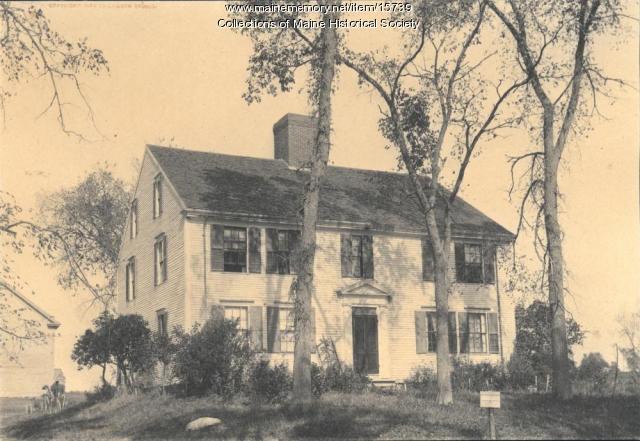Keywords: town
- Historical Items (4913)
- Tax Records (0)
- Architecture & Landscape (102)
- Online Exhibits (187)
- Site Pages (949)
- My Maine Stories (76)
- Lesson Plans (5)
Lesson Plans
Your results include these lesson plans. Your results include these lesson plans.
Lesson Plan
Building Community/Community Buildings
Grade Level: 6-8
Content Area: Social Studies
Where do people gather? What defines a community? What buildings allow people to congregate to celebrate, learn, debate, vote, and take part in all manner of community activities? Students will evaluate images and primary documents from throughout Maine’s history, and look at some of Maine’s earliest gathering spaces and organizations, and how many communities established themselves around certain types of buildings. Students will make connections between the community buildings of the past and the ways we express identity and create communities today.
Lesson Plan
Primary Sources: The Maine Shipyard
Grade Level: 9-12
Content Area: Social Studies
This lesson plan will give students a close-up look at historical operations behind Maine's famed shipbuilding and shipping industries. Students will examine primary sources including letters, bills of lading, images, and objects, and draw informed hypotheses about the evolution of the seafaring industry and its impact on Maine’s communities over time.
Lesson Plan
An Exploration into Maine's History
Grade Level: 3-5
Content Area: Social Studies
This investigation was designed to utilize the resources of the Maine Memory Network and the Library of Congress. Students will have the opportunity to create their own albums from MMN, research their local history, and that of the state of Maine. This is a progressive approach that begins with an investigation into Yarmouth, Maine’s history, however, it could easily be adapted for any home town. Part of the exploration includes suggested visits to the local historical society and discussions with the school historian.
The creative writing piece calls for students to become someone who lived in their town 100 years ago; they find the information they need be research on MMN and the Library of Congress and then write and share their stories. Along each step of the way, students created, saved, and shared albums of materials related to their research and work on MMN. The second part of this lesson is designed to coincide with the study of the history of the state of Maine and of the United States.
Lesson Plan
Longfellow Studies: The Elms - Stephen Longfellow's Gorham Farm
Grade Level: 6-8, 9-12
Content Area: English Language Arts, Social Studies
On April 3, 1761 Stephen Longfellow II signed the deed for the first 100 acre purchase of land that he would own in Gorham, Maine. His son Stephen III (Judge Longfellow) would build a home on that property which still stands to this day. Judge Longfellow would become one of the most prominent citizens in Gorhams history and one of the earliest influences on his grandson Henry Wadsworth Longfellow's work as a poet.
This exhibit examines why the Longfellows arrived in Gorham, Judge Longfellow's role in the history of the town, Henry Wadsworth Longfellow's vacations in the country which may have influenced his greatest work, and the remains of the Longfellow estate still standing in Gorham today.
Lesson Plan
Grade Level: 3-5, 6-8, 9-12
Content Area: Social Studies, Visual & Performing Arts
"In the four quarters of the globe, who reads an American book?" Englishman Sydney Smith's 1820 sneer irked Americans, especially writers such as Irving, Cooper, Hawthorne, and Maine's John Neal, until Henry Wadsworth Longfellow's resounding popularity successfully rebuffed the question. The Bowdoin educated Portland native became the America's first superstar poet, paradoxically loved especially in Britain, even memorialized at Westminster Abbey. He achieved international celebrity with about forty books or translations to his credit between 1830 and 1884, and, like superstars today, his public craved pictures of him. His publishers consequently commissioned Longfellow's portrait more often than his family, and he sat for dozens of original paintings, drawings, and photos during his lifetime, as well as sculptures. Engravers and lithographers printed replicas of the originals as book frontispiece, as illustrations for magazine or newspaper articles, and as post cards or "cabinet" cards handed out to admirers, often autographed. After the poet's death, illustrators continued commercial production of his image for new editions of his writings and coloring books or games such as "Authors," and sculptors commemorated him with busts in Longfellow Schools or full-length figures in town squares. On the simple basis of quantity, the number of reproductions of the Maine native's image arguably marks him as the country's best-known nineteenth century writer. TEACHERS can use this presentation to discuss these themes in art, history, English, or humanities classes, or to lead into the following LESSON PLANS. The plans aim for any 9-12 high school studio art class, but they can also be used in any humanities course, such as literature or history. They can be adapted readily for grades 3-8 as well by modifying instructional language, evaluation rubrics, and targeted Maine Learning Results and by selecting materials for appropriate age level.






